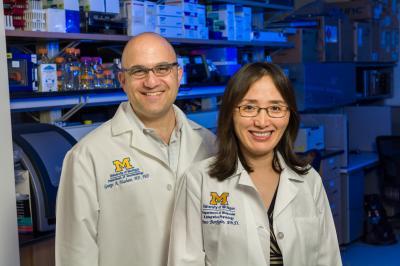This study is probably the first step in explaining the elusive nature of the near-death-experience (NDE). For years, many neuroscientists have believed that these NDEs were the result of brain activity at the moment of and in the moments following cardiac arrest.
The researchers analyzed the recordings of brain activity called electroencephalograms (EEGs) from nine anesthetized rats undergoing experimentally induced cardiac arrest. Within the first 30 seconds after cardiac arrest, all of the rats displayed a widespread, transient surge of highly synchronized brain activity that had features associated with a highly aroused brain.
Furthermore, the authors observed nearly identical patterns in the dying brains of rats undergoing asphyxiation.Interesting and important research . . . but only that. More research and better models are needed.
Near-Death Experiences Verified? Dying Brains Show Electrical Signatures Of Consciousness
By News Staff | August 12th 2013
Near-death experiences may have found a new grounding in science.
Whether and how the dying brain is capable of generating conscious activity has been vigorously debated but the near-death experiences reported by cardiac arrest survivors worldwide may be verifiable, according to a new paper.
Approximately 20 percent of cardiac arrest survivors report having had a near-death experience during clinical death. These visions and perceptions have been called "realer than real" but it remains unclear whether the brain is capable of such activity after cardiac arrest.
A new paper found that shortly after clinical death, in which the heart stops beating and blood stops flowing to the brain, rats display brain activity patterns characteristic of conscious perception.
"This study, performed in animals, is the first dealing with what happens to the neurophysiological state of the dying brain," says lead study author Jimo Borjigin, Ph.D., associate professor of molecular and integrative physiology and associate professor of neurology at the University of Michigan Medical School. "It will form the foundation for future human studies investigating mental experiences occurring in the dying brain, including seeing light during cardiac arrest.
"We reasoned that if near-death experience stems from brain activity, neural correlates of consciousness should be identifiable in humans or animals even after the cessation of cerebral blood flow."
University of Michigan researchers George Mashour, M.D., Ph.D., and Jimo Borjigin, Ph.D., form the foundation for investigating mental experiences occurring in the dying brain, including seeing the light during cardiac arrest. Credit: University of Michigan Health System
The researchers analyzed the recordings of brain activity called electroencephalograms (EEGs) from nine anesthetized rats undergoing experimentally induced cardiac arrest. Within the first 30 seconds after cardiac arrest, all of the rats displayed a widespread, transient surge of highly synchronized brain activity that had features associated with a highly aroused brain.
Furthermore, the authors observed nearly identical patterns in the dying brains of rats undergoing asphyxiation.
"The prediction that we would find some signs of conscious activity in the brain during cardiac arrest was confirmed with the data," says Borjigin, who conceived the project in 2007 with study co-author neurologist Michael M. Wang, M.D., Ph.D., associate professor of neurology and associate professor of molecular and integrative physiology at the University of Michigan.
"But, we were surprised by the high levels of activity," adds study senior author anesthesiologist George Mashour, M.D., Ph.D., assistant professor of anesthesiology and neurosurgery. " In fact, at near-death, many known electrical signatures of consciousness exceeded levels found in the waking state, suggesting that the brain is capable of well-organized electrical activity during the early stage of clinical death."
The brain is assumed to be inactive during cardiac arrest. However the neurophysiological state of the brain immediately following cardiac arrest had not been systemically investigated until now.
"This study tells us that reduction of oxygen or both oxygen and glucose during cardiac arrest can stimulate brain activity that is characteristic of conscious processing," says Borjigin. "It also provides the first scientific framework for the near-death experiences reported by many cardiac arrest survivors."
Full Citation:
Jimo Borjigin, UnCheol Lee, Tiecheng Liu, Dinesh Pal, Sean Huff, Daniel Klarr, Jennifer Sloboda, Jason Hernandez, Michael M. Wang, and George A. Mashour, (2013, Aug 12). Surge of neurophysiological coherence and connectivity in the dying brain. PNAS, doi:10.1073/pnas.1308285110
AbstractThe brain is assumed to be hypoactive during cardiac arrest. However, the neurophysiological state of the brain immediately following cardiac arrest has not been systematically investigated. In this study, we performed continuous electroencephalography in rats undergoing experimental cardiac arrest and analyzed changes in power density, coherence, directed connectivity, and cross-frequency coupling. We identified a transient surge of synchronous gamma oscillations that occurred within the first 30 s after cardiac arrest and preceded isoelectric electroencephalogram. Gamma oscillations during cardiac arrest were global and highly coherent; moreover, this frequency band exhibited a striking increase in anterior–posterior-directed connectivity and tight phase-coupling to both theta and alpha waves. High-frequency neurophysiological activity in the near-death state exceeded levels found during the conscious waking state. These data demonstrate that the mammalian brain can, albeit paradoxically, generate neural correlates of heightened conscious processing at near-death.

No comments:
Post a Comment